Ram ProMaster 2014 Owner's Guide
Manufacturer: RAM, Model Year: 2014, Model line: ProMaster, Model: Ram ProMaster 2014Pages: 410, PDF Size: 2.83 MB
Page 31 of 410
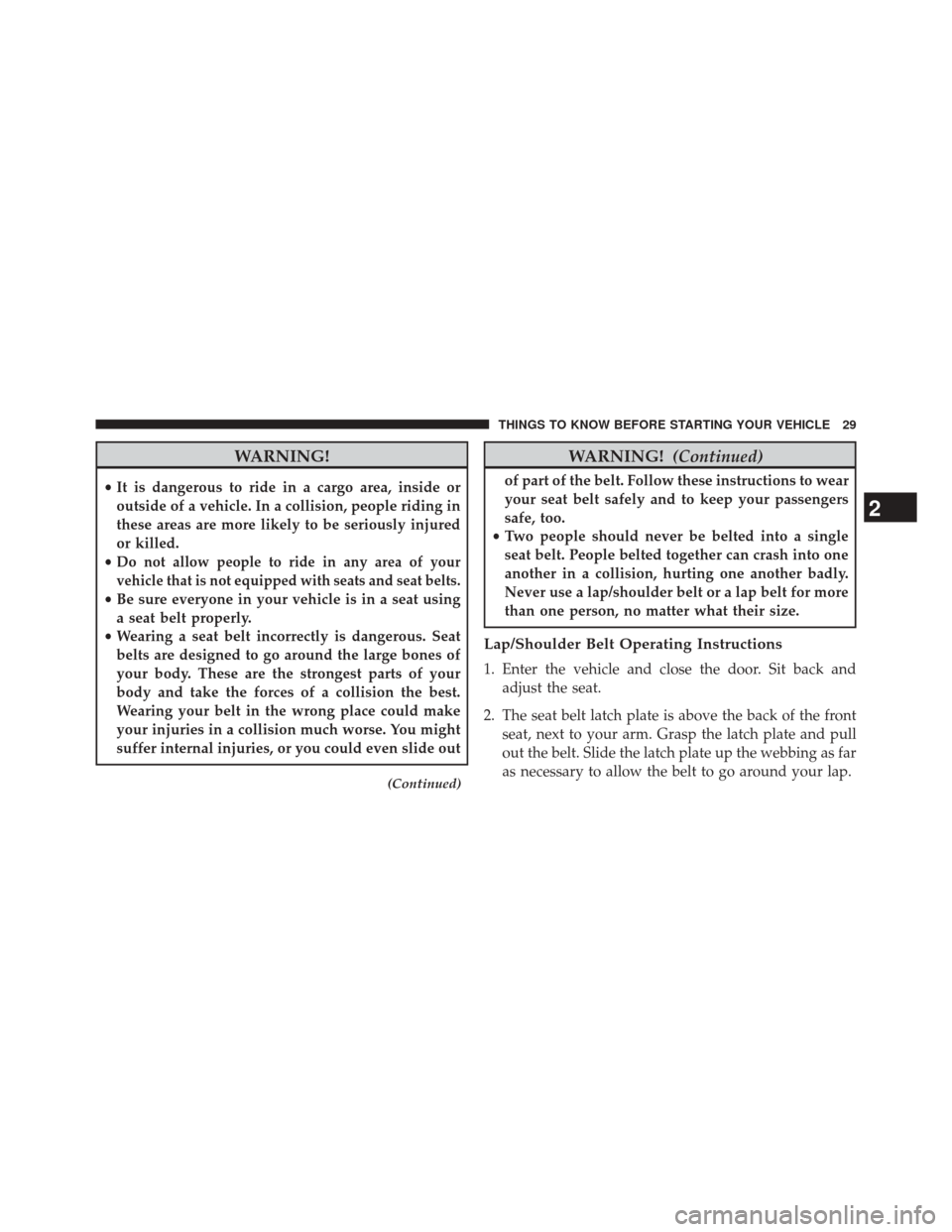
WARNING!
•It is dangerous to ride in a cargo area, inside or
outside of a vehicle. In a collision, people riding in
these areas are more likely to be seriously injured
or killed.
•
Do not allow people to ride in any area of your
vehicle that is not equipped with seats and seat belts.
• Be sure everyone in your vehicle is in a seat using
a seat belt properly.
• Wearing a seat belt incorrectly is dangerous. Seat
belts are designed to go around the large bones of
your body. These are the strongest parts of your
body and take the forces of a collision the best.
Wearing your belt in the wrong place could make
your injuries in a collision much worse. You might
suffer internal injuries, or you could even slide out
(Continued)
WARNING! (Continued)
of part of the belt. Follow these instructions to wear
your seat belt safely and to keep your passengers
safe, too.
• Two people should never be belted into a single
seat belt. People belted together can crash into one
another in a collision, hurting one another badly.
Never use a lap/shoulder belt or a lap belt for more
than one person, no matter what their size.
Lap/Shoulder Belt Operating Instructions
1. Enter the vehicle and close the door. Sit back and adjust the seat.
2. The seat belt latch plate is above the back of the front seat, next to your arm. Grasp the latch plate and pull
out the belt. Slide the latch plate up the webbing as far
as necessary to allow the belt to go around your lap.
2
THINGS TO KNOW BEFORE STARTING YOUR VEHICLE 29
Page 32 of 410
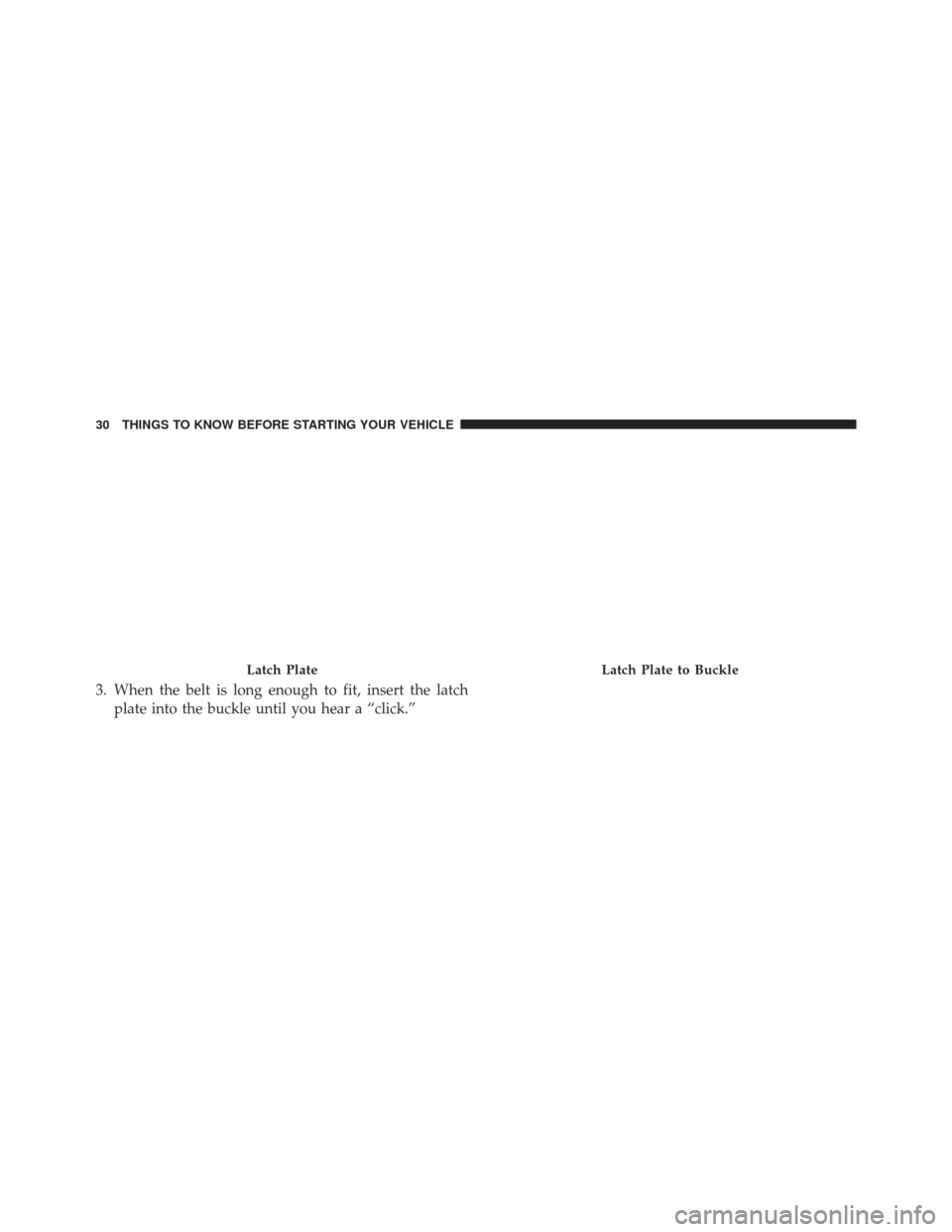
3. When the belt is long enough to fit, insert the latchplate into the buckle until you hear a “click.”
Latch PlateLatch Plate to Buckle
30 THINGS TO KNOW BEFORE STARTING YOUR VEHICLE
Page 33 of 410
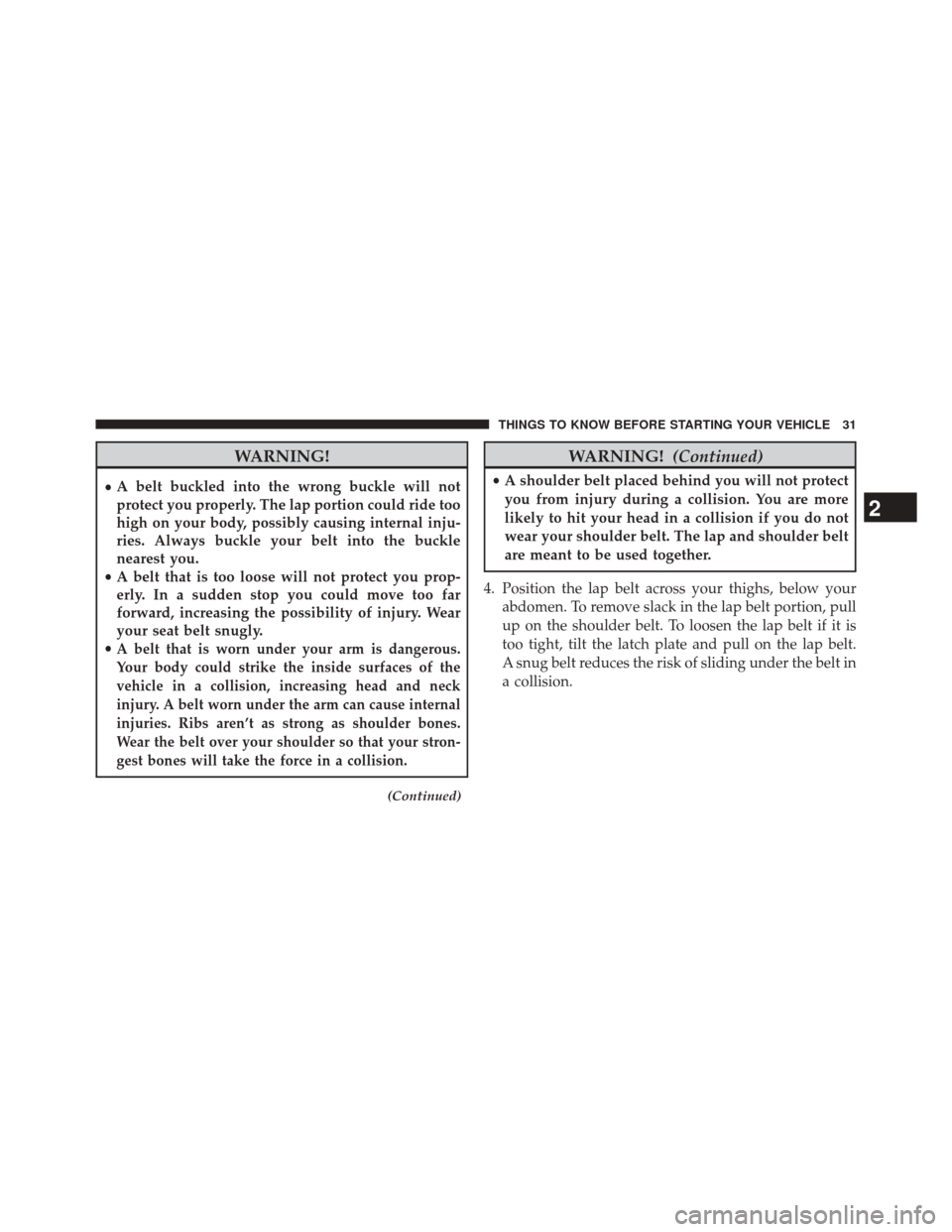
WARNING!
•A belt buckled into the wrong buckle will not
protect you properly. The lap portion could ride too
high on your body, possibly causing internal inju-
ries. Always buckle your belt into the buckle
nearest you.
• A belt that is too loose will not protect you prop-
erly. In a sudden stop you could move too far
forward, increasing the possibility of injury. Wear
your seat belt snugly.
•
A belt that is worn under your arm is dangerous.
Your body could strike the inside surfaces of the
vehicle in a collision, increasing head and neck
injury. A belt worn under the arm can cause internal
injuries. Ribs aren’t as strong as shoulder bones.
Wear the belt over your shoulder so that your stron-
gest bones will take the force in a collision.
(Continued)
WARNING! (Continued)
•A shoulder belt placed behind you will not protect
you from injury during a collision. You are more
likely to hit your head in a collision if you do not
wear your shoulder belt. The lap and shoulder belt
are meant to be used together.
4. Position the lap belt across your thighs, below your abdomen. To remove slack in the lap belt portion, pull
up on the shoulder belt. To loosen the lap belt if it is
too tight, tilt the latch plate and pull on the lap belt.
A snug belt reduces the risk of sliding under the belt in
a collision.
2
THINGS TO KNOW BEFORE STARTING YOUR VEHICLE 31
Page 34 of 410
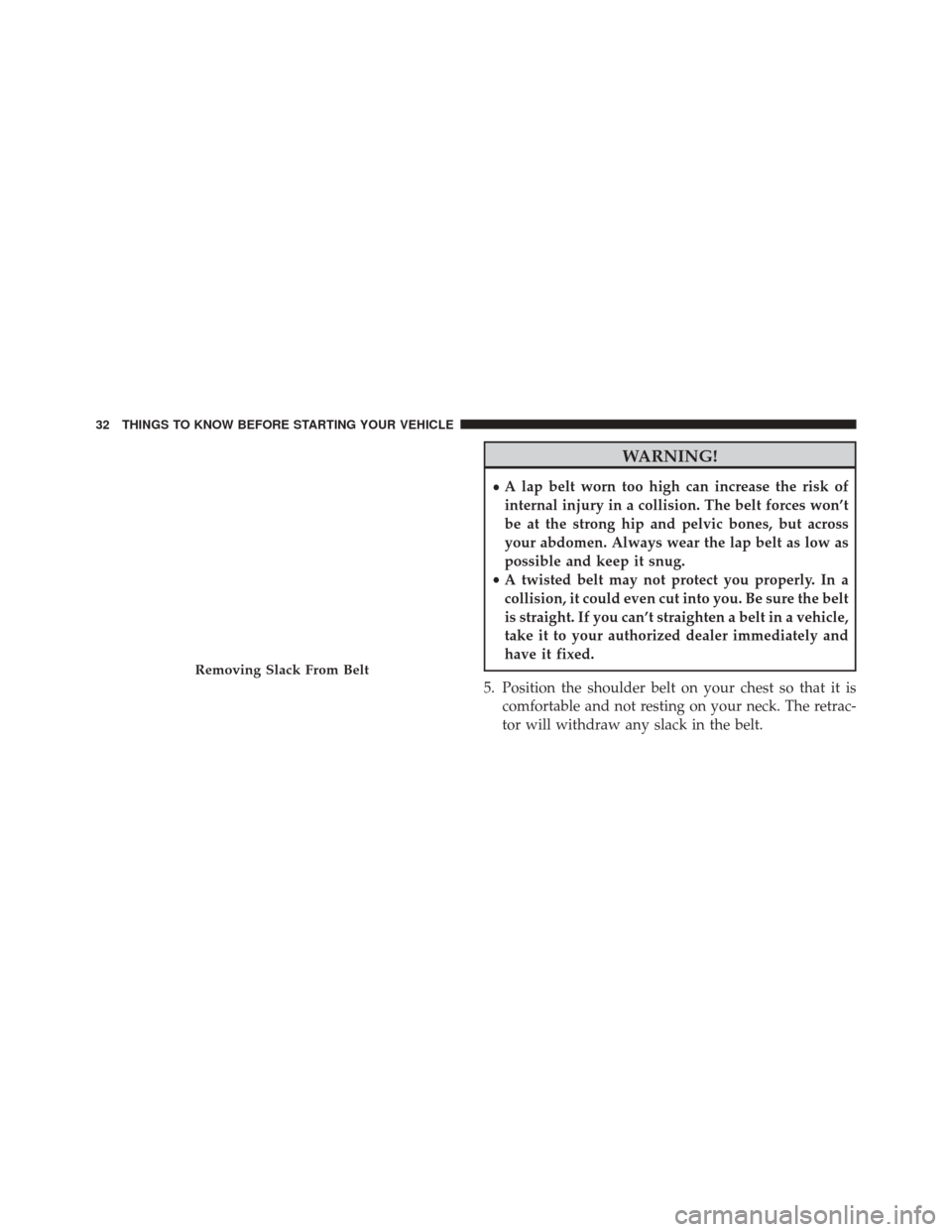
WARNING!
•A lap belt worn too high can increase the risk of
internal injury in a collision. The belt forces won’t
be at the strong hip and pelvic bones, but across
your abdomen. Always wear the lap belt as low as
possible and keep it snug.
• A twisted belt may not protect you properly. In a
collision, it could even cut into you. Be sure the belt
is straight. If you can’t straighten a belt in a vehicle,
take it to your authorized dealer immediately and
have it fixed.
5. Position the shoulder belt on your chest so that it is comfortable and not resting on your neck. The retrac-
tor will withdraw any slack in the belt.
Removing Slack From Belt
32 THINGS TO KNOW BEFORE STARTING YOUR VEHICLE
Page 35 of 410

6. To release the belt, push the red button on the buckle.The belt will automatically retract to its stowed posi-
tion. If necessary, slide the latch plate down the
webbing to allow the belt to retract fully.
WARNING!
A frayed or torn belt could rip apart in a collision and
leave you with no protection. Inspect the belt system
periodically, checking for cuts, frays, or loose parts.
Damaged parts must be replaced immediately. Do
not disassemble or modify the system. Seat belt
assemblies must be replaced after a collision if they
have been damaged (bent retractor, torn webbing,
etc.) or if the air bag deployed.
Lap/Shoulder Belt Untwisting Procedure
Use the following procedure to untwist a twisted lap/
shoulder belt.
1. Position the latch plate as close as possible to theanchor point.
2. At about 6 to 12 in (15 to 30 cm) above the latch plate, grasp and twist the belt webbing 180 degrees to create
a fold that begins immediately above the latch plate.
3. Slide the latch plate upward over the folded webbing. The folded webbing must enter the slot at the top of
the latch plate.
4. Continue to slide the latch plate up until it clears the folded webbing.
2
THINGS TO KNOW BEFORE STARTING YOUR VEHICLE 33
Page 36 of 410
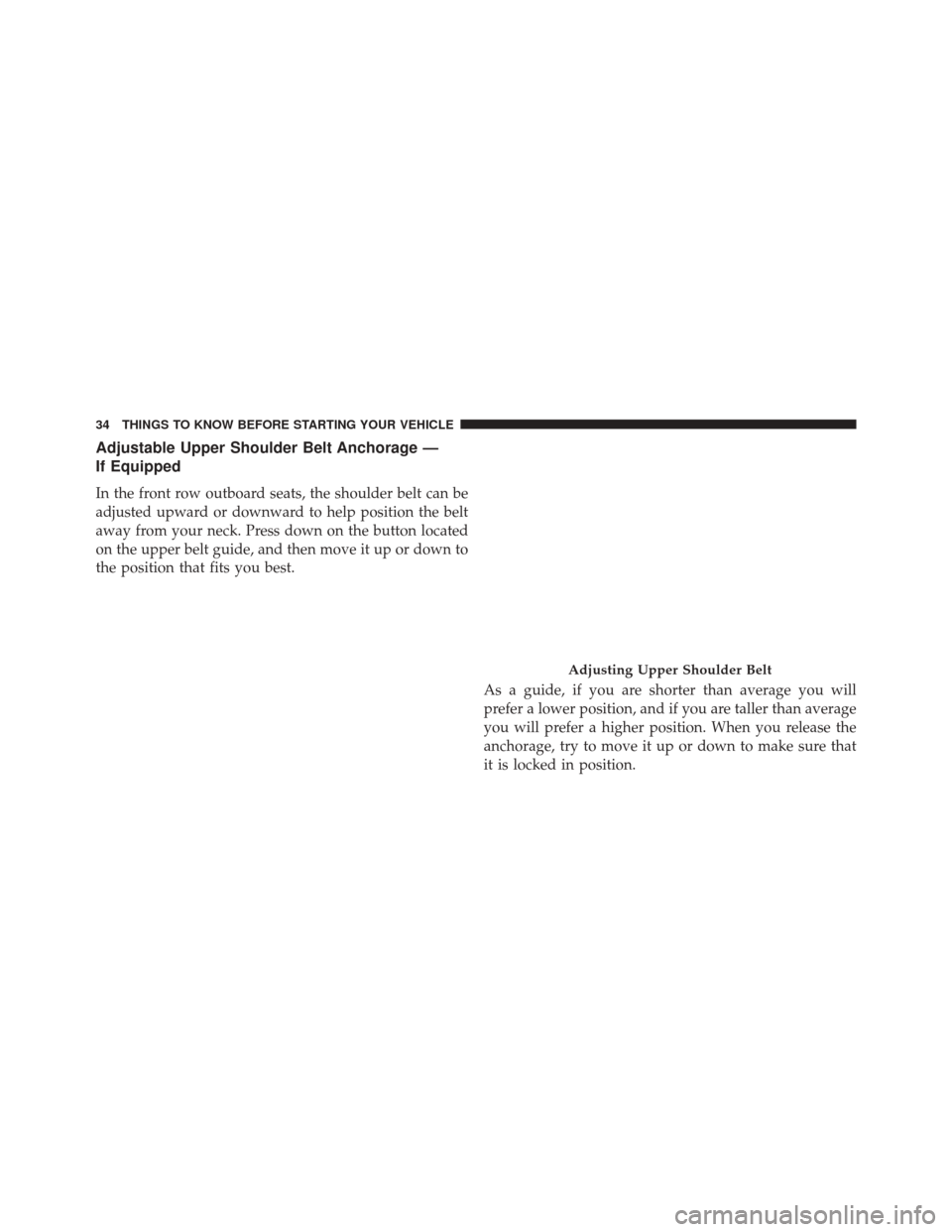
Adjustable Upper Shoulder Belt Anchorage —
If Equipped
In the front row outboard seats, the shoulder belt can be
adjusted upward or downward to help position the belt
away from your neck. Press down on the button located
on the upper belt guide, and then move it up or down to
the position that fits you best.As a guide, if you are shorter than average you will
prefer a lower position, and if you are taller than average
you will prefer a higher position. When you release the
anchorage, try to move it up or down to make sure that
it is locked in position.
Adjusting Upper Shoulder Belt
34 THINGS TO KNOW BEFORE STARTING YOUR VEHICLE
Page 37 of 410
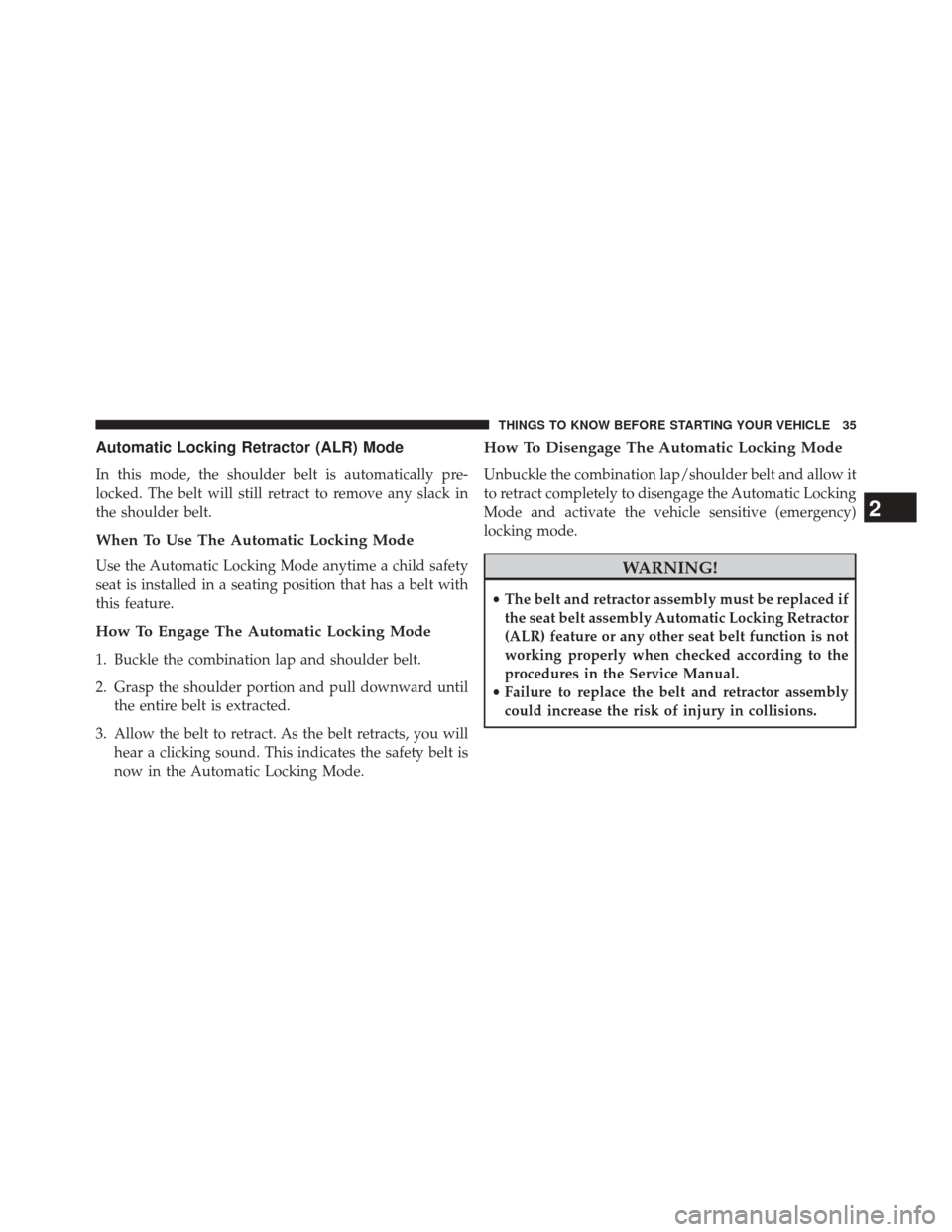
Automatic Locking Retractor (ALR) Mode
In this mode, the shoulder belt is automatically pre-
locked. The belt will still retract to remove any slack in
the shoulder belt.
When To Use The Automatic Locking Mode
Use the Automatic Locking Mode anytime a child safety
seat is installed in a seating position that has a belt with
this feature.
How To Engage The Automatic Locking Mode
1. Buckle the combination lap and shoulder belt.
2. Grasp the shoulder portion and pull downward untilthe entire belt is extracted.
3. Allow the belt to retract. As the belt retracts, you will hear a clicking sound. This indicates the safety belt is
now in the Automatic Locking Mode.
How To Disengage The Automatic Locking Mode
Unbuckle the combination lap/shoulder belt and allow it
to retract completely to disengage the Automatic Locking
Mode and activate the vehicle sensitive (emergency)
locking mode.
WARNING!
•The belt and retractor assembly must be replaced if
the seat belt assembly Automatic Locking Retractor
(ALR) feature or any other seat belt function is not
working properly when checked according to the
procedures in the Service Manual.
• Failure to replace the belt and retractor assembly
could increase the risk of injury in collisions.
2
THINGS TO KNOW BEFORE STARTING YOUR VEHICLE 35
Page 38 of 410
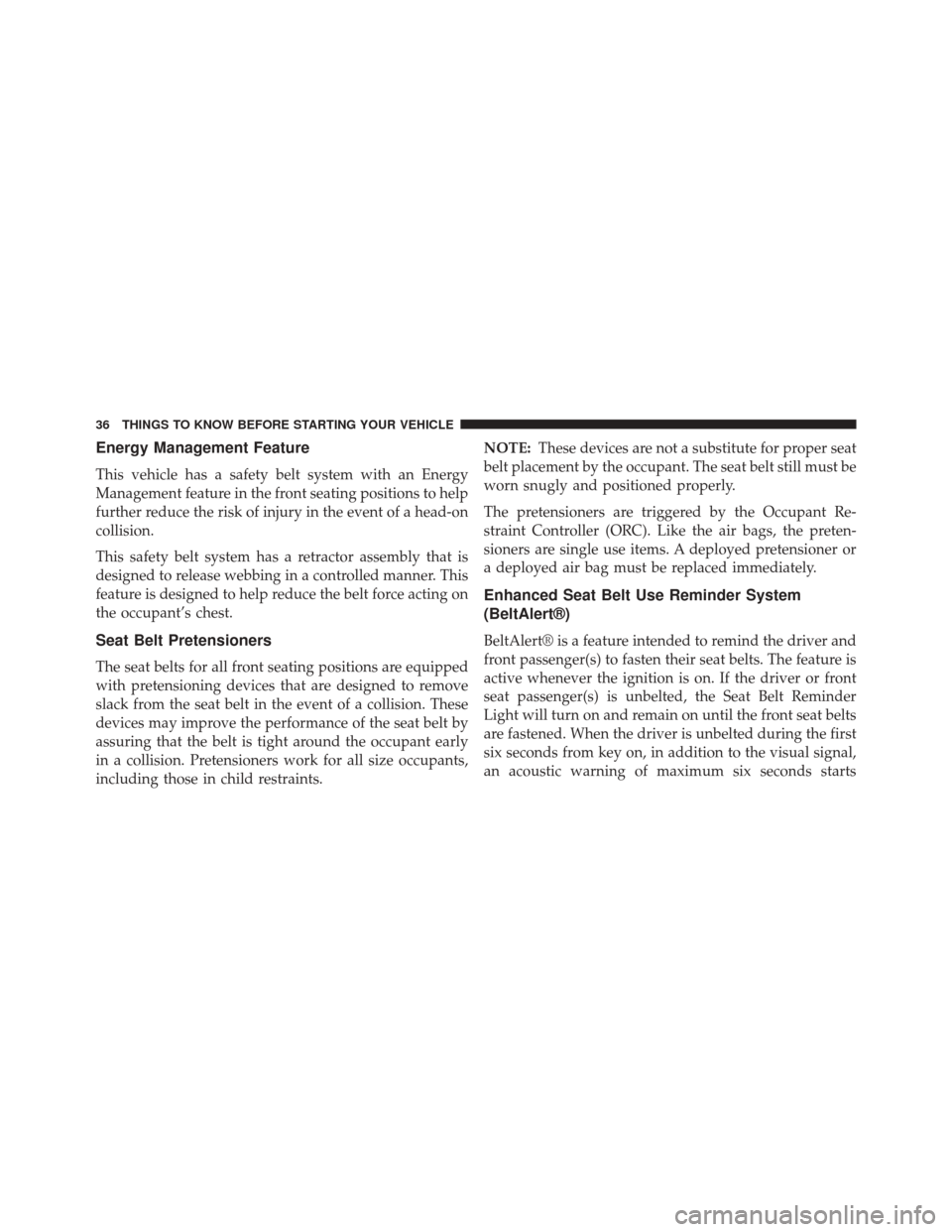
Energy Management Feature
This vehicle has a safety belt system with an Energy
Management feature in the front seating positions to help
further reduce the risk of injury in the event of a head-on
collision.
This safety belt system has a retractor assembly that is
designed to release webbing in a controlled manner. This
feature is designed to help reduce the belt force acting on
the occupant’s chest.
Seat Belt Pretensioners
The seat belts for all front seating positions are equipped
with pretensioning devices that are designed to remove
slack from the seat belt in the event of a collision. These
devices may improve the performance of the seat belt by
assuring that the belt is tight around the occupant early
in a collision. Pretensioners work for all size occupants,
including those in child restraints.NOTE:
These devices are not a substitute for proper seat
belt placement by the occupant. The seat belt still must be
worn snugly and positioned properly.
The pretensioners are triggered by the Occupant Re-
straint Controller (ORC). Like the air bags, the preten-
sioners are single use items. A deployed pretensioner or
a deployed air bag must be replaced immediately.
Enhanced Seat Belt Use Reminder System
(BeltAlert®)
BeltAlert® is a feature intended to remind the driver and
front passenger(s) to fasten their seat belts. The feature is
active whenever the ignition is on. If the driver or front
seat passenger(s) is unbelted, the Seat Belt Reminder
Light will turn on and remain on until the front seat belts
are fastened. When the driver is unbelted during the first
six seconds from key on, in addition to the visual signal,
an acoustic warning of maximum six seconds starts
36 THINGS TO KNOW BEFORE STARTING YOUR VEHICLE
Page 39 of 410
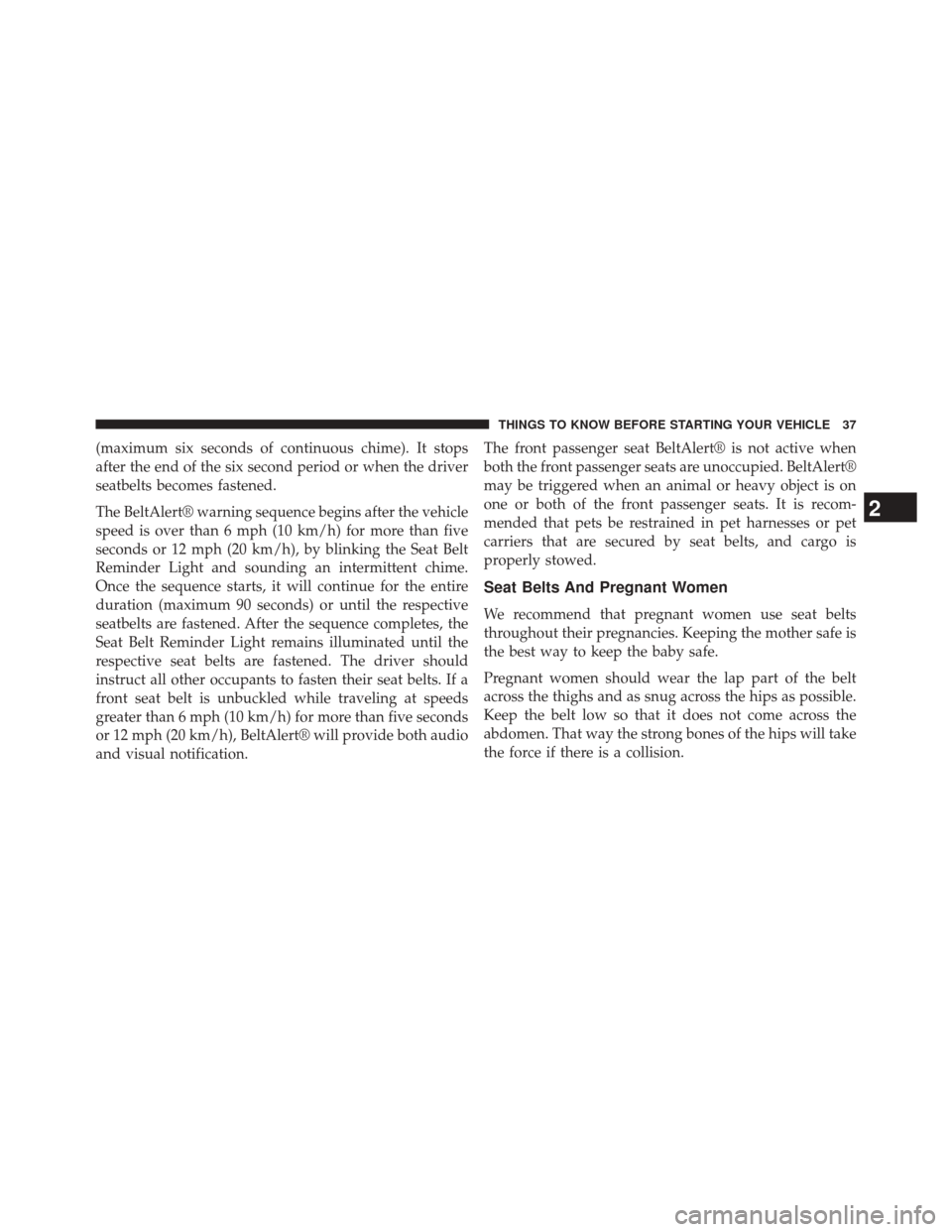
(maximum six seconds of continuous chime). It stops
after the end of the six second period or when the driver
seatbelts becomes fastened.
The BeltAlert® warning sequence begins after the vehicle
speed is over than 6 mph (10 km/h) for more than five
seconds or 12 mph (20 km/h), by blinking the Seat Belt
Reminder Light and sounding an intermittent chime.
Once the sequence starts, it will continue for the entire
duration (maximum 90 seconds) or until the respective
seatbelts are fastened. After the sequence completes, the
Seat Belt Reminder Light remains illuminated until the
respective seat belts are fastened. The driver should
instruct all other occupants to fasten their seat belts. If a
front seat belt is unbuckled while traveling at speeds
greater than 6 mph (10 km/h) for more than five seconds
or 12 mph (20 km/h), BeltAlert® will provide both audio
and visual notification.The front passenger seat BeltAlert® is not active when
both the front passenger seats are unoccupied. BeltAlert®
may be triggered when an animal or heavy object is on
one or both of the front passenger seats. It is recom-
mended that pets be restrained in pet harnesses or pet
carriers that are secured by seat belts, and cargo is
properly stowed.
Seat Belts And Pregnant Women
We recommend that pregnant women use seat belts
throughout their pregnancies. Keeping the mother safe is
the best way to keep the baby safe.
Pregnant women should wear the lap part of the belt
across the thighs and as snug across the hips as possible.
Keep the belt low so that it does not come across the
abdomen. That way the strong bones of the hips will take
the force if there is a collision.
2
THINGS TO KNOW BEFORE STARTING YOUR VEHICLE 37
Page 40 of 410
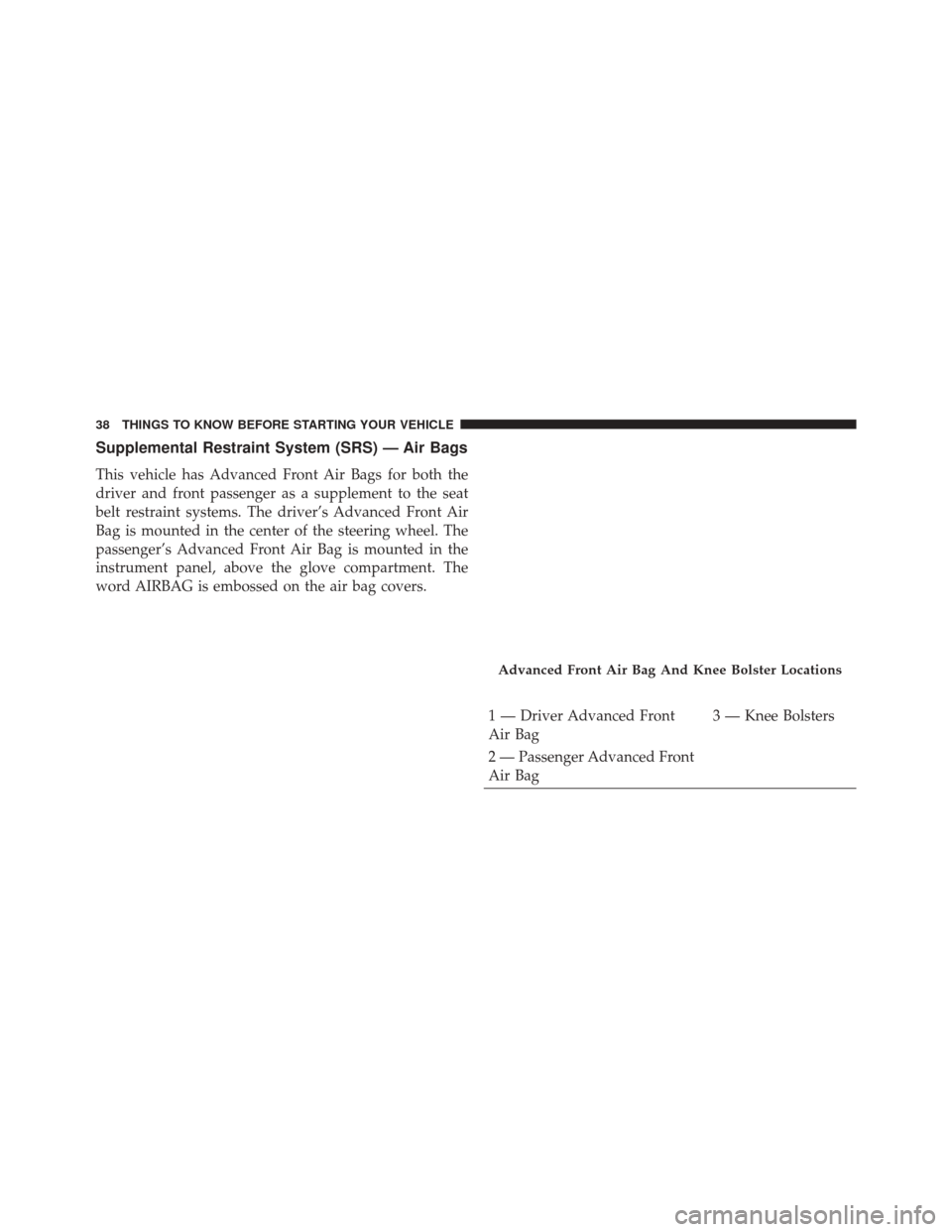
Supplemental Restraint System (SRS) — Air Bags
This vehicle has Advanced Front Air Bags for both the
driver and front passenger as a supplement to the seat
belt restraint systems. The driver’s Advanced Front Air
Bag is mounted in the center of the steering wheel. The
passenger’s Advanced Front Air Bag is mounted in the
instrument panel, above the glove compartment. The
word AIRBAG is embossed on the air bag covers.
Advanced Front Air Bag And Knee Bolster Locations
1 — Driver Advanced Front
Air Bag3 — Knee Bolsters
2 — Passenger Advanced Front
Air Bag
38 THINGS TO KNOW BEFORE STARTING YOUR VEHICLE